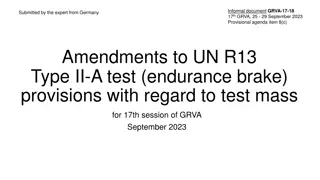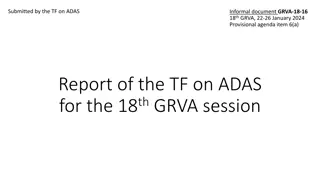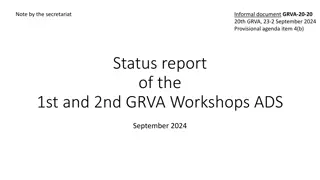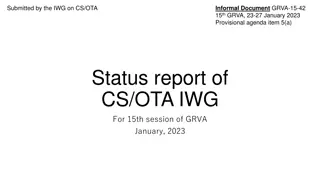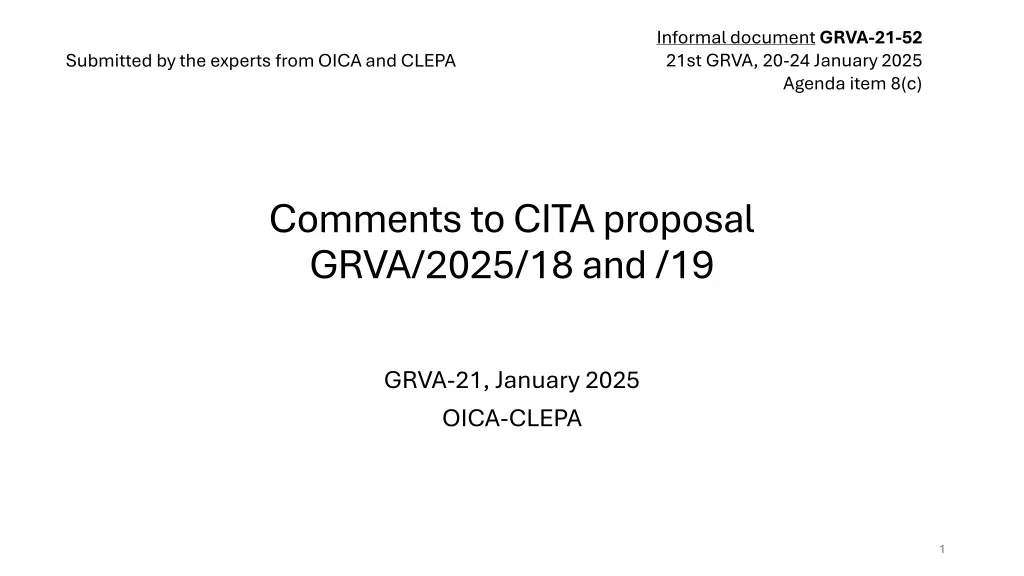
Braking Force Methods and OBD Tools Discussion
Experts from OICA and CLEPA provide comments on CITA's proposal regarding braking force methods and OBD scan tools in the automotive industry. They highlight concerns about cyber-security risks, the impact on inspection centers, and the premature specification of new requirements post the EBSIG amendment adoption. Various methods of measuring braking forces and their safety implications are discussed in the context of current and future technologies.
Download Presentation

Please find below an Image/Link to download the presentation.
The content on the website is provided AS IS for your information and personal use only. It may not be sold, licensed, or shared on other websites without obtaining consent from the author. If you encounter any issues during the download, it is possible that the publisher has removed the file from their server.
You are allowed to download the files provided on this website for personal or commercial use, subject to the condition that they are used lawfully. All files are the property of their respective owners.
The content on the website is provided AS IS for your information and personal use only. It may not be sold, licensed, or shared on other websites without obtaining consent from the author.
E N D
Presentation Transcript
Informal documentGRVA-21-52 21st GRVA, 20-24 January2025 Agenda item 8(c) Submitted by the experts fromOICA and CLEPA Comments to CITA proposal GRVA/2025/18 and /19 GRVA-21, January 2025 OICA-CLEPA 1
Rationales 1. Numerous countries are not using reference braking force but other methods, with same / comparable safety levels and efficiency. 2. The EBSIG amendment has just been adopted, it is premature to already specify new requirements for PTI, which would impact both the product and the equipment of the inspection centers. The idea when the EBSIG amendment was adopted was to let new methods develop as the electric braking technology will deploy. 3. CITA paper GRVA-20-39 justifies the implementation of OBD scan tools with the need to measure dynamic values at 1 Hz. Given the linearity of the brake curves, a simple extrapolation based on one measurement point could be sufficient. It seems feasible for an inspector to read one value. 4. Opening the OBD interface increases the risk on Cyber-Security. 5. Industry is not positive to the idea to open the door to such OBD-based PTI solutions, especially for a major safety system like braking, while other efficient solutions exist and new ones will develop in the future. 2
Pneumatic braking (current) About reference braking forces Measurement on roller brake tester Method using reference braking forces Method not using reference braking forces Brake force Brake force OK OK 5m/s at GVW 5m/s at GVW reference braking forces Actuator pressure Actuator pressure (Case where the adhesion is sufficient) Same safety level 3
Pneumatic braking (current) About reference braking forces Measurement on roller brake tester Method using reference braking forces Method not using reference braking forces Brake force Brake force OK 5m/s at GVW 5m/s at GVW OK Adhesion limit Adhesion limit reference braking forces Actuator pressure Actuator pressure Max (Case where the adhesion limits the measured force) Same safety level 4
Electric Braking (ETBS) About the need for an electronic scan tool Measurement on roller brake tester Method using reference braking forces with OBD Method using reference braking forces without OBD Brake force Brake force 5m/s at GVW 5m/s at GVW OK OK Adhesion limit Adhesion limit reference braking forces reference braking forces Brake demand Brake demand (read on dashboard) (from OBD) Need to Plug the electronic scan tool Need to invest in an OBD scan tool Need to maintain the OBD data and the scan tool accordingly Need to read one brake demand value 5
Summary Reference braking force is one possible method, but not the only one Numerous countries are using different methods, with same / comparable safety levels The use of an OBD scan tool is not a must to ensure a good quality of brake assessment at PTI : reading one brake demand value looks feasible The EBSIG amendment have just been adopted, it is premature to already specify new requirements for PTI. We should let the technology deploy and develop new solutions. Opening the OBD interface increases the risk on Cyber-Security. Industry is not positive to opening the door to such technical solutions, especially for a major safety system like braking. 6

